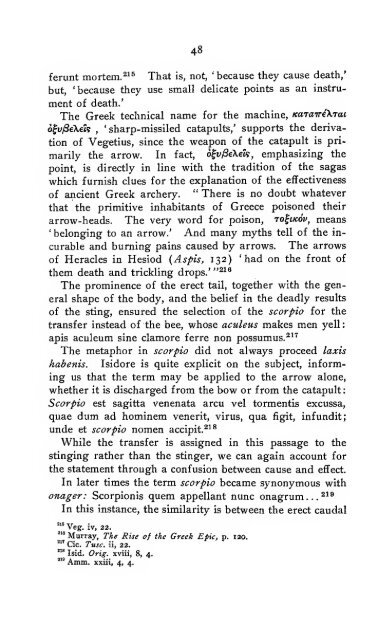Figurative uses of animal names in Latin and their ... - mura di tutti
Figurative uses of animal names in Latin and their ... - mura di tutti
Figurative uses of animal names in Latin and their ... - mura di tutti
You also want an ePaper? Increase the reach of your titles
YUMPU automatically turns print PDFs into web optimized ePapers that Google loves.
48<br />
ferunt mortem. ^^^ That is, not, ' because they cause death,'<br />
but, 'because they use small delicate po<strong>in</strong>ts as an <strong>in</strong>strument<br />
<strong>of</strong> death.'<br />
The Greek technical name for the mach<strong>in</strong>e, /caraireXrai<br />
<strong>of</strong>u/8e\e«? ,<br />
' sharp-missiled catapults,' supports the deriva-<br />
tion <strong>of</strong> Vegetius, s<strong>in</strong>ce the weapon <strong>of</strong> the catapult is pri-<br />
marily the arrow. In fact, <strong>of</strong>v/3e\e«, emphasiz<strong>in</strong>g the<br />
po<strong>in</strong>t, is <strong>di</strong>rectly <strong>in</strong> l<strong>in</strong>e with the tra<strong>di</strong>tion <strong>of</strong> the sagas<br />
which furnish clues for the explanation <strong>of</strong> the effectiveness<br />
<strong>of</strong> ancient Greek archery. " There is no doubt whatever<br />
that the primitive <strong>in</strong>habitants <strong>of</strong> Greece poisoned <strong>their</strong><br />
arrow-heads. The very word for poison, to^ikov, means<br />
' belong<strong>in</strong>g to an arrow.' And many myths tell <strong>of</strong> the <strong>in</strong>-<br />
curable <strong>and</strong> burn<strong>in</strong>g pa<strong>in</strong>s caused by arrows. The arrows<br />
<strong>of</strong> Heracles <strong>in</strong> Hesiod {Aspis, 132) 'had on the front <strong>of</strong><br />
them death <strong>and</strong> trickl<strong>in</strong>g drops.' "^^^<br />
The prom<strong>in</strong>ence <strong>of</strong> the erect tail, together with the gen-<br />
eral shape <strong>of</strong> the body, <strong>and</strong> the belief <strong>in</strong> the deadly results<br />
<strong>of</strong> the st<strong>in</strong>g, ensured the selection <strong>of</strong> the scorpio for the<br />
transfer <strong>in</strong>stead <strong>of</strong> the bee, whose aculeus makes men yell<br />
apis aculeum s<strong>in</strong>e clamore ferre non possumus.^^^<br />
The metaphor <strong>in</strong> scorpio <strong>di</strong>d not always proceed laxis<br />
habenis. Isidore is quite explicit on the subject, <strong>in</strong>form-<br />
<strong>in</strong>g us that the term may be applied to the arrow alone,<br />
whether it is <strong>di</strong>scharged from the bow or from the catapult<br />
Scorpio est sagitta venenata arcu vel tormentis excussa,<br />
quae dum ad hom<strong>in</strong>em venerit, virus, qua figit, <strong>in</strong>fun<strong>di</strong>t;<br />
unde et scorpio nomen accipit.^^*<br />
While the transfer is assigned <strong>in</strong> this passage to the<br />
st<strong>in</strong>g<strong>in</strong>g rather than the st<strong>in</strong>ger, we can aga<strong>in</strong> account for<br />
the statement through a confusion between cause <strong>and</strong> effect.<br />
In later times the term scorpio became synonymous with<br />
^*®<br />
onager: Scorpionis quem appellant nunc onagrum. . .<br />
In this <strong>in</strong>stance, the similarity is between the erect caudal<br />
''" Veg. iv, 22.<br />
"'° Murray, The Rise <strong>of</strong> the Greek Epic, p. 120.<br />
^' Cic. Tusc. ii, 22.<br />
Isid. Orig. xviii, 8, 4.<br />
Amm. xxiii, 4, 4.<br />
:



![Das Kriegswesen der Alten [microform] - mura di tutti](https://img.yumpu.com/21606999/1/167x260/das-kriegswesen-der-alten-microform-mura-di-tutti.jpg?quality=85)








